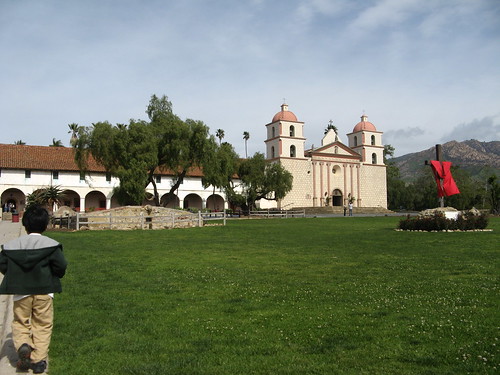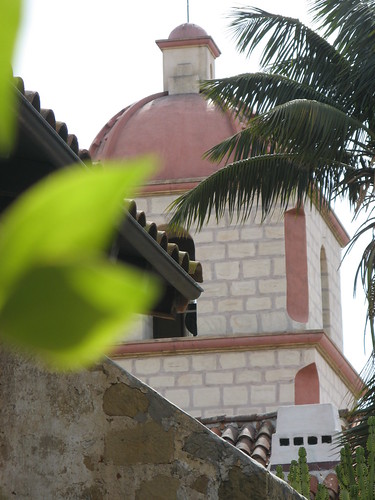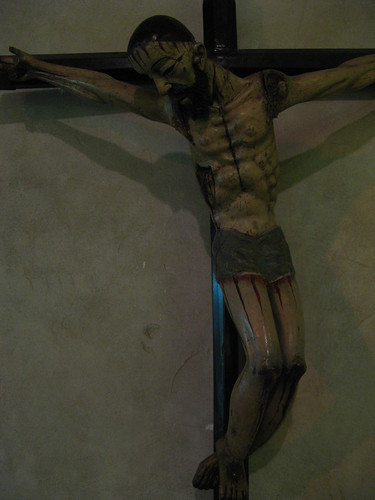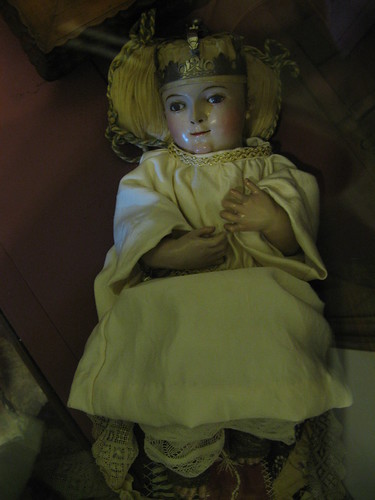Fra Junípero Serra spent years of his life hiking north from Mexico, determined to convert local Indian tribes to Christianity, and establishing a chain of missions, each no more than a day's hard hike from the previous one. Having set up nine, he arrived at the foothills of the Santa Ynez mountains aiming to create the tenth. He died before he could do so, and it was his successor, Fermin Francisco de Lasuen, who raised the cross here in 1786. 224 years later, here we are, gawking at this example of neoclassical monasticism, the Old Mission in Santa Barbara. Its lovely lines belie the brutality of the Spanish conquest and conversion of California. The Franciscans who lived and worked here introduced agriculture to the local Chumash; at the same time, they brought virulent disease that decimated the local population, destroyed the local culture, and flayed the survivors into submission.
224 years later, here we are, gawking at this example of neoclassical monasticism, the Old Mission in Santa Barbara. Its lovely lines belie the brutality of the Spanish conquest and conversion of California. The Franciscans who lived and worked here introduced agriculture to the local Chumash; at the same time, they brought virulent disease that decimated the local population, destroyed the local culture, and flayed the survivors into submission.
The Chumash used to be hunters both on land and on river in their tolmols (plank canoes). Their villages were led by hereditary leaders. Early encounters with the white man indicated that their artistry in handicraft and manufactures was much appreciated. After Serra and his cohorts arrived, the Chumash were forced into settled lives, and taught agronomy, carpentry, masonry, and European music in an effort to 'civilise' them. They learnt to cultivate oranges and olives and vine. A large aqueduct to bring water for irrigation from the moutains was constructed, along with a storage reservoir.
 What we see today are not the original buildings, which were adobe and unpretentious. The last adobe church was destroyed in an earthquake in 1812, after which the present church was planned. It was finished in 1870, wrecked in another earthquake in 1925, restored in 1927 and reinforced in 1953.
What we see today are not the original buildings, which were adobe and unpretentious. The last adobe church was destroyed in an earthquake in 1812, after which the present church was planned. It was finished in 1870, wrecked in another earthquake in 1925, restored in 1927 and reinforced in 1953.
After the evangelisation of the Chumash successfully concluded in the 1830s, the mission was secularised, and the Indians fell under the civil administration of Mexico (which had taken over California from Spain only 8 years earlier). Both the lifestyle of the occupants of the friary and the condition of the mission began to suffer under civilian neglect. While other missions in Southern California were deconsecrated and converted to bars, or abandoned, the Santa Barbara mission's church continued to offer prayers.
 There is a cemetery within the mission grounds. Various worthies are buried here, and nearly four thousand Indians, including Juana Maria, the Lone Woman of San Nicolas island, the last survivor of her Nicoleño tribe. Her grave is lost among the many in the grounds (there is a plaque, however, raised in her honour).
There is a cemetery within the mission grounds. Various worthies are buried here, and nearly four thousand Indians, including Juana Maria, the Lone Woman of San Nicolas island, the last survivor of her Nicoleño tribe. Her grave is lost among the many in the grounds (there is a plaque, however, raised in her honour).
In the post-evangelical period, the mission buildings were alternately a school and junior college, and seminary. Today, the church is part of the parish of St. Barbara, and used enthusiastically by the largely Hispanic underclass of the area.

 There is a multitude of cultural influences in the Santa Barbara mission. We saw a Philippine cross, vestments of Chinese silk, Chinese porcelain, California Indian basketry, Mexican art works. A lovely baptismal Christ doll rounds off the list of little treasures.
There is a multitude of cultural influences in the Santa Barbara mission. We saw a Philippine cross, vestments of Chinese silk, Chinese porcelain, California Indian basketry, Mexican art works. A lovely baptismal Christ doll rounds off the list of little treasures.
 224 years later, here we are, gawking at this example of neoclassical monasticism, the Old Mission in Santa Barbara. Its lovely lines belie the brutality of the Spanish conquest and conversion of California. The Franciscans who lived and worked here introduced agriculture to the local Chumash; at the same time, they brought virulent disease that decimated the local population, destroyed the local culture, and flayed the survivors into submission.
224 years later, here we are, gawking at this example of neoclassical monasticism, the Old Mission in Santa Barbara. Its lovely lines belie the brutality of the Spanish conquest and conversion of California. The Franciscans who lived and worked here introduced agriculture to the local Chumash; at the same time, they brought virulent disease that decimated the local population, destroyed the local culture, and flayed the survivors into submission.The Chumash used to be hunters both on land and on river in their tolmols (plank canoes). Their villages were led by hereditary leaders. Early encounters with the white man indicated that their artistry in handicraft and manufactures was much appreciated. After Serra and his cohorts arrived, the Chumash were forced into settled lives, and taught agronomy, carpentry, masonry, and European music in an effort to 'civilise' them. They learnt to cultivate oranges and olives and vine. A large aqueduct to bring water for irrigation from the moutains was constructed, along with a storage reservoir.
 What we see today are not the original buildings, which were adobe and unpretentious. The last adobe church was destroyed in an earthquake in 1812, after which the present church was planned. It was finished in 1870, wrecked in another earthquake in 1925, restored in 1927 and reinforced in 1953.
What we see today are not the original buildings, which were adobe and unpretentious. The last adobe church was destroyed in an earthquake in 1812, after which the present church was planned. It was finished in 1870, wrecked in another earthquake in 1925, restored in 1927 and reinforced in 1953.After the evangelisation of the Chumash successfully concluded in the 1830s, the mission was secularised, and the Indians fell under the civil administration of Mexico (which had taken over California from Spain only 8 years earlier). Both the lifestyle of the occupants of the friary and the condition of the mission began to suffer under civilian neglect. While other missions in Southern California were deconsecrated and converted to bars, or abandoned, the Santa Barbara mission's church continued to offer prayers.
 There is a cemetery within the mission grounds. Various worthies are buried here, and nearly four thousand Indians, including Juana Maria, the Lone Woman of San Nicolas island, the last survivor of her Nicoleño tribe. Her grave is lost among the many in the grounds (there is a plaque, however, raised in her honour).
There is a cemetery within the mission grounds. Various worthies are buried here, and nearly four thousand Indians, including Juana Maria, the Lone Woman of San Nicolas island, the last survivor of her Nicoleño tribe. Her grave is lost among the many in the grounds (there is a plaque, however, raised in her honour).In the post-evangelical period, the mission buildings were alternately a school and junior college, and seminary. Today, the church is part of the parish of St. Barbara, and used enthusiastically by the largely Hispanic underclass of the area.

 There is a multitude of cultural influences in the Santa Barbara mission. We saw a Philippine cross, vestments of Chinese silk, Chinese porcelain, California Indian basketry, Mexican art works. A lovely baptismal Christ doll rounds off the list of little treasures.
There is a multitude of cultural influences in the Santa Barbara mission. We saw a Philippine cross, vestments of Chinese silk, Chinese porcelain, California Indian basketry, Mexican art works. A lovely baptismal Christ doll rounds off the list of little treasures.
2 comments:
nice post on the history of the mission
The last time I was there, I was just too excited about the string of missions we could do day treks to and the various indian tribes who lived along the path.
.....and ofcourse the oldest photographs of the mission about 125 years old
i'd love to do a 'pilgrimage' trek from mission #1 to mission #21, but i suspect i'll either get run over by the traffic on highway 1, or incarcerated by police as an illegal. ;-)
Post a Comment